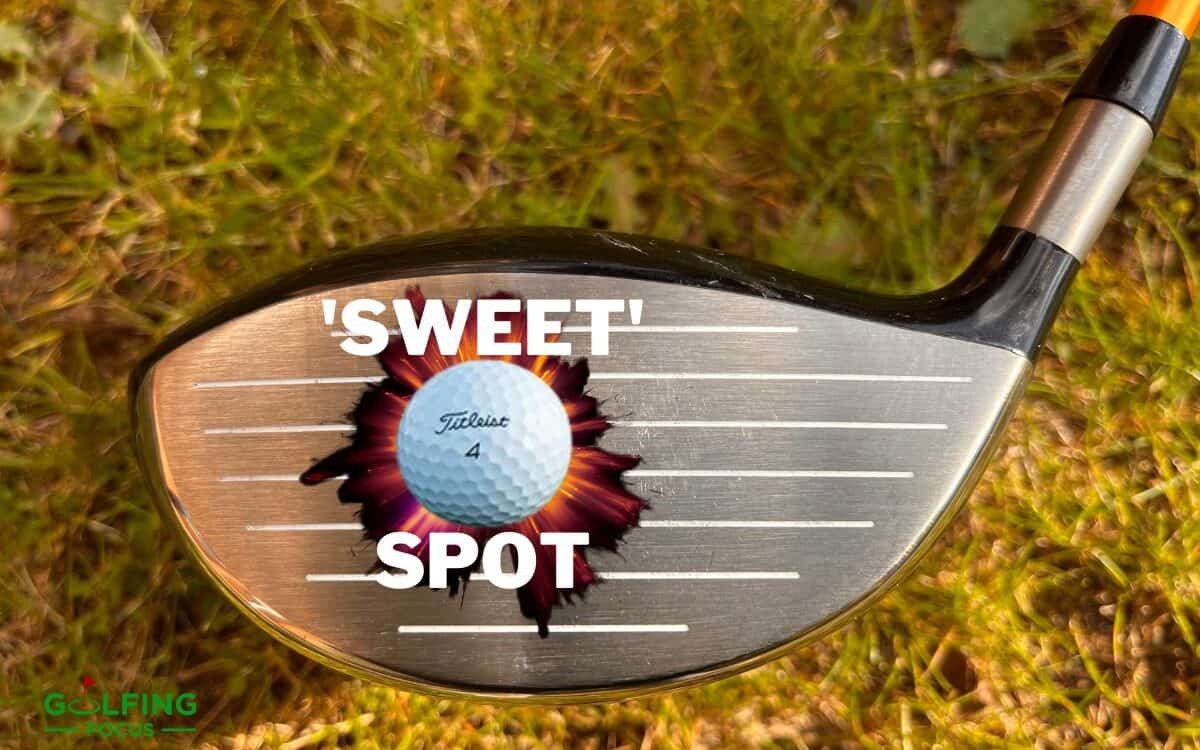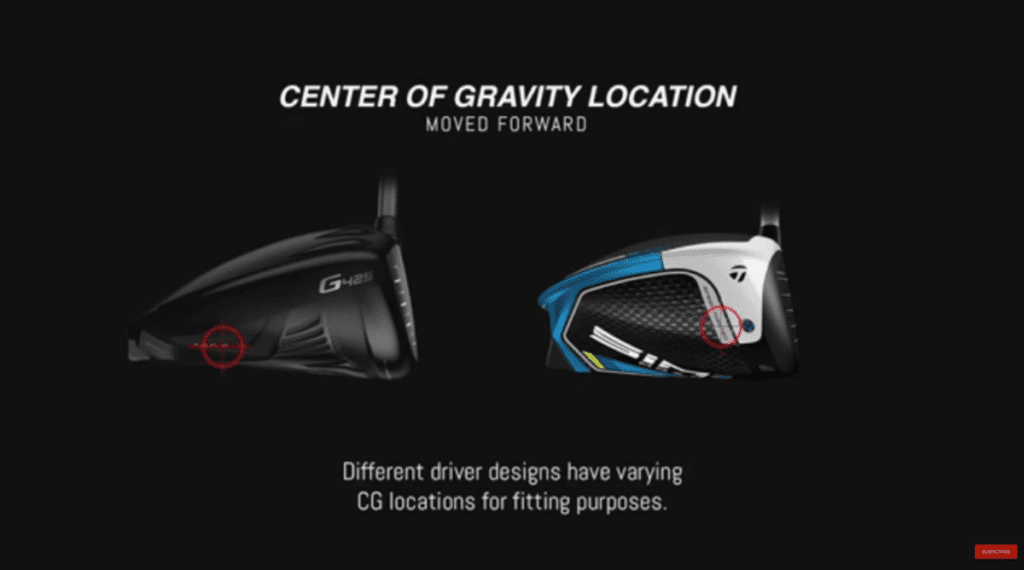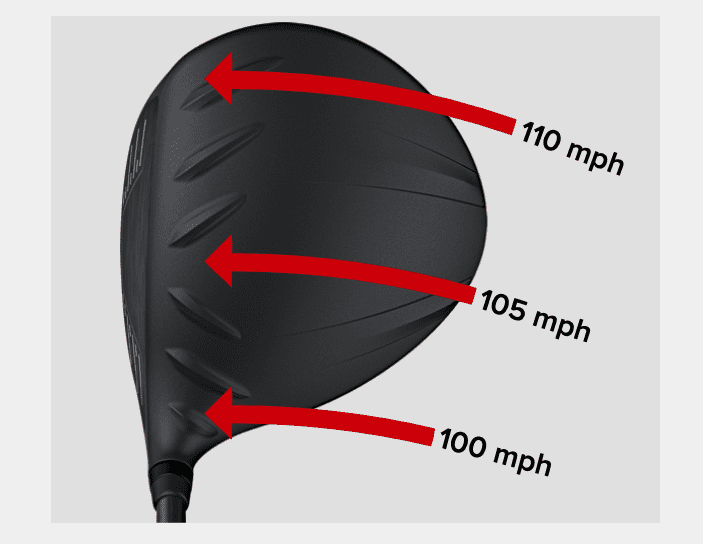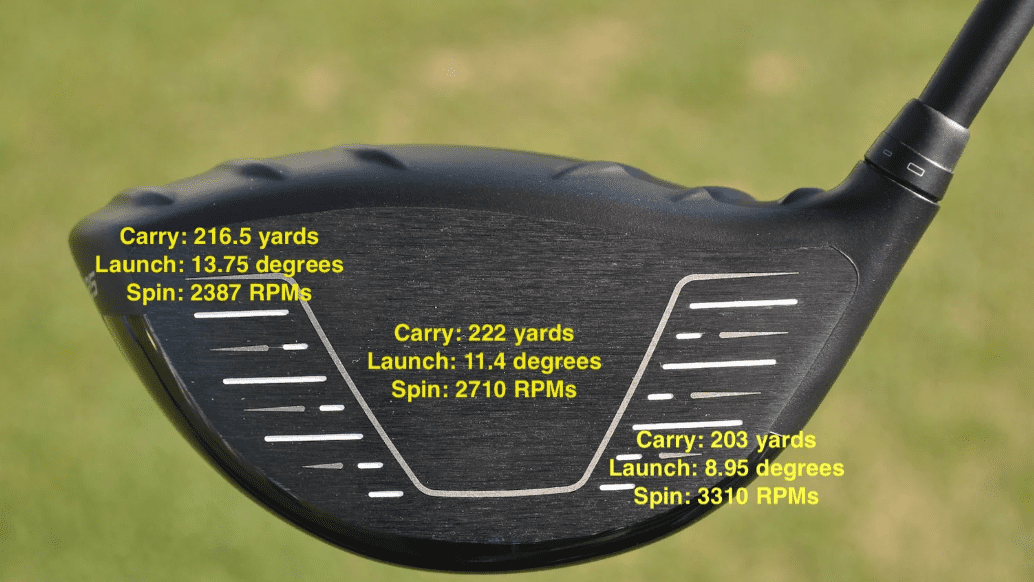Where is the Sweet Spot on the Driver Face? Take the High Road

If you have played golf for any length of time you will have been a first hand witness to a lot of changes in driver technology.
Since hollow metal woods started to emerge in the 1980s, to oversized and then titanium drivers becoming widespread in the 1990s, through to modern versions where you can easily change the loft and weighting of the club yourself driver tech has been on a consistent march forward for the last number of decades.
And to such an extent that today it is legitimate to question where on the driver’s face it is best to hit a golf ball because gone are the days when golfers could simply assume the centre is the absolute ideal.
The sweet spot on a modern driver is marginally above the centre and towards the toe of the face. This slightly ‘off centre’ spot maximizes ball speed and therefore distance because the toe of the club travels up to 14% faster than the heel due to it rotating and closing so rapidly as it nears the ball.
I don’t know about you but it has always taken me a while to wrap my head around the fact that a strike out of the middle of the driver is not ‘perfect’ when it comes to maximizing distance with the overwhelming majority of modern drivers.
A centre strike is of course still going to serve you very very well when it comes to hitting your driver as far as possible, and while it may no longer be deemed the absolute ‘ideal’ – and as we will illustrate later on – it will not serve you too well if you start to drift much too far away from the centre or sweet spot!
In addition, when it comes to driving distance in the modern game it is also worth knowing if you really want to hit a big drive on a particular hole whether it is best to focus on keeping it sweet when it comes to strike or going for more swingspeed instead!

Where You Should Hit on the Driver Clubface is Off Center!
In the days of old wooden persimmon drivers there was little argument around where on the face every golfer should be aiming to hit their driver.
But fast forward a few decades and the advances in every aspect of driver design – from the basic size to the materials used, to the huge amounts of technology hidden from plain sight within the modern clubhead – and the answer to where on the face you should ideally hit driver is not as straight forward as it used to be.
Before we answer that question in more detail though it is worth just confirming what we are aiming for with the driver.
Yes, that may sound obvious but as we all know in golf things are never that simple.
The accuracy versus distance debate has raged for a long time and still today you will find golfers passionately arguing how important it is to hit fairways off the tee over all other things.
While it is of course true that it is better to be on the fairway than not, this argument misses the main point upon which all stats gurus, and indeed all the top pros, are today universally agreed.
And that is that distance is king off the tee, and assuming you can keep the ball within bounds in an area that allows you a viable next shot (including the rough!), you should be aiming to get as many yards as possible off the tee if you don’t want to put a limit on how much you can improve.
Thankfully to help us the modern driver is packed with technology – from more simple elements like its length, weight, and loft to more complex factors including its gear effect, face material, and thickness – all of which are painstakingly designed to help golfers of all standards maximize their distance off the tee.
And when it comes to where is best to hit the golf ball on modern golf drivers it turns out an off-centre strike – slightly up from the centre of the face and towards the toe – will deliver you the maximum amount of distance.
Further, the reason for this relates to the key when it comes to distance in golf – namely ‘speed’!
According to Trackman, one of the leading launch manufacturers in golf launch monitor technology, for every one mph of ‘ball speed’ you can increase driver distance by up to 2 yards, while adding 1 mph of club/swing speed can increase your distance by up to 3 yards.
We delve into ‘ball speed’ and ‘club/swing speed’ and how they impact driver distance alongside the other key factors in much more detail in another one of our posts you can find here, but in short why it matters when it comes to where you should hit the ball on the driver face is specifically related to club/swing speed.
Because to get more distance off the tee one of the best things you can do is to increase your clubhead speed.
Driver clubhead speeds can get pretty fast though, especially when in the hands of top players, and because the club is rotating and closing so quickly as it gets to the ball, the toe of the club is estimated to be traveling around 14% faster than the heel of the club.

And given we now know, thanks to launch monitors, that more clubhead speed means more distance it makes sense therefore that in order to maximize distance the best place for you to strike the ball on your driver club face is not quite in the centre.
But as anyone who has played even one game of golf is well aware it is a very hard game and for the vast majority of amateurs, it is not an easy thing to hit the ball off the sweet spot of the driver on a consistent basis.
As the legendary Ben Hogan once said – “Golf is a game of misses (and) he who misses best, wins” – so given that, and how hard it actually is to strike a driver perfectly it is probably worth us looking next at where you should ‘miss’ hit on your driver club face!

[Note – If you are interested in learning more about why you should be ignoring traditional golf stats such as fairways hit % check out our detailed look at the numbers you should be keeping track of if you really want to improve!]
If You’re Going to Miss Should You Hit High or Low on Driver?
While it is all very well to talk about sweet spots on drivers, as all regular golfers know all to well, striking the ball near the middle of the club can prove to be a very elusive thing on lots of occasions.
Poorly struck drives are far more common than well-struck ones in a lot of amateur rounds and as such it makes sense for us to consider where on the driver club face you are better to mishit than another.
As a general rule golfers should hit high up rather than low on the face of a modern golf driver. According to industry testing leader Golf Laboratories, a 95mph swingspeed golfer will lose only 5.5 yards of carry distance when a drive is struck on the high toe compared to a centre hit but lose 19 yards with a low heel strike.
Now this is of course is not to say that you should not aim to strike your drives out of the sweet spot just slightly up from centre and towards the toe, or the exact center itself, but golf club manufacturers are well that regular players frequently miss these spots and most often do so with a high toe or low heel strike.
As a consequence of this modern driver designs incorporate a ‘curvature’ on the driver’s face from top to bottom with the purpose of creating a ‘vertical gear effect’ on very common off-centre driver hits high or low on the driver’s face.
And this ‘gear effect’ is the reason why poorly struck drives no longer lose as much distance as they would have once done with older drivers.
Because in more simple terms what gear effect aims to do is impart draw spin on a high toe strike, and slice spin on a low heel strike, as the ball hits the driver’s face in an effort to ‘bend’ the ball back towards the intended direction.
It is not a perfect science of course and no driver technology in the world is going to turn a poorly struck drive into a good one but the purpose of ‘gear effect’ is to try and minimize the damage as far as possible.
As we can see from the results of Golf Laboratories’ robot experiment above – that mimicked an average golfer with a 95mph driver clubhead speed and attack angle of 0º – drives struck high on the toe lost under 300rpms of spin and launched with at an increased angle of 2.35º but went only 5.5 carry yards less than a centre hit.
Hitting the ball low on the face and off the heel by comparison however had a much more significant effect with close to 20 yards of carry distance being lost due to the vastly increased spin rate (+600rpms compared to a centre strike) and low launch angle (-2.45º).
Renowned PGA and Golf Digest instructor and club fitter James Leitz estimates based on his analysis of driver strikes that you will see an 8 to 9mph decrease in ball speed with a low struck drive on the heel or toe compared to a 2-4mph reduction when the ball hits the driver face anywhere else other than the center.
So from a distance perspective, the key point to remember is that hitting the ball low on the driver’s face -and/or off the heel – will significantly reduce how far you hit the ball, and if you are going to miss it is better to miss high on the face rather than low if you want to try and keep up with your best struck drives.
Saying that however many good players struggling for confidence with their driver, or simply aiming to keep the ball in play, will deliberately target hitting low on the driver club face to ensure a low launch and high spinning straight shot that’s not going to roll very far in any direction once it hits the ground.
And as any regular golfer knows all too well, a high toe strike can very easily stray from an acceptable draw to an ugly snap hook on the basis of only a millimeter in one direction or the other, so while high is the best place to miss for distance with a driver strike the target is of course always the sweet spot!
Pro tip: A cheap and easy way to work on your ball striking is to practice on the driving range with a little foot powder spray on your club. It lets you see where the ball struck the face and wipes off easily.
Does a Better Strike or More Swingspeed Maximise Driver Distance?
We’ve all been there.
You step on the tee and feel this is the hole that you need to crank it up and send the ball that extra few yards than you normally do because it is on this occasion that you know it will make all the difference.
So bearing in mind what we’ve already covered, if the next hole is the one you need to send your driver out that bit further than normal, are you better to focus on hitting the sweet spot or instead loosening off those muscles in an effort to generate that extra bit of swingspeed that ‘potentially’ can mean more distance?
Once again we can turn to an experiment run by golf technology expert Gene Parente at Golf Laboratories with Golf.com where he analyzed what happens when a player hits driver in the center of the face compared to them hitting both centre and multiple off-center strikes with swing speeds increased by 5 and 10mph.
Starting with the most straight forward results – and as we would expect – Parente found that if you strike the ball in the centre of the clubface you will gain 11 yards of distance by increasing your swingspeed from 95mph – roughly the driver speed of the average male amateur – to 100mph.
And if you reach 105mph, again with a centre strike, you will again hit the ball further but this time an additional 5mph of swingspeed to 105mph will only gain you an additional 2 yards or 13 yards in total compared to a 95mph swing.
Further for mishits he discovered that you will still hit the ball further with 5mph or more increased driver swingspeed if you strike the ball up to 1 inch off centre or on the upper third of the clubface.
“The one thing I focus on more than anything else is just good contact. Strike it solid because if you strike it solid obviously more times than not it’s going to work out in your favour”.
Rory McIlroy – 4-time Major Champion aand former World No.1
Strike the ball on the lower third of the clubface or anywhere past 1 inch off centre however and you will undoubtedly lose distance by up to as much as 8 yards even if you get that swingspeed number up to 105mph from 95mph.
So as we can see increased driver swingspeed is a sure fire way to potentially get more distance off the tee but there are clearly trade offs to be aware if you decide to focus on speed rather than strike when you want to hit that big drive.
Firstly, if you are an average golfer you would need to weigh up whether going for a lot of extra speed is actually worth it especially when you consider only 2 extra yards of distance is on offer when you go from 100mph and 105mph.
And secondly these tests were based on a robot striking the ball with a club face which was absolutely square at impact so if you were increase your speed in line with this experiment – but hit the ball with a face which was not square – you may find a ball going a bit further but a bit further in the wrong direction!
The lesson to take therefore is that if you are going to focus on generating some extra swing speed to get a bit more distance off the tee make sure your misshits are high on the face rather than low but bear in mind you may pay the price when it comes to accuracy!
[Editor’s note – If you are consistently missing the sweet spot of your driver and sacrificing distance as a result check out our top 10 tips for getting more distance off the tee with and without extra swingspeed!]
Other top posts related to this topic:
- How Far Should You Hit a Driver? FULL GUIDE By Age, Handicap etc.
- How Far Should Your Driver Swingspeed Go? 60 to 120 mph Guide
- Why Don’t Your Drives Go Far? Slow and Steady Loses the Race
- How Far Should Your Ball Speed Go? 100mph All the Way to 210mph!
- What Should Your Driver Attack Angle Be? Try Not to Be Negative
- How Much Does Driver Loft Affect Distance? Loft is Dynamic Too!
- Ideal Spin Rate and Launch Angle for Driver? That’s Personal!
- Average Driver Swingspeeds? COMPLETE GUIDE by Age, Handicap etc.
- Should Beginners & High Handicappers Use a Driver? Yes & Yes
- Can You Get Your Existing Golf Clubs Fitted? Complexity = Cost!
- Should I Get Fitted for Golf Clubs Before Lessons? Get Both Together
- Best Places to Get Fitted for Golf Clubs – Full Guide (with Best Fitter Search List)
- How Do Pros Hit the Ball So Far? It’s Not About the Equipment!
- Do Distance Golf Balls Go Further? Marketing Matters
- Do All Golf Balls Go the Same Distance? Physics First
- What Affects Golf Ball Distance? Beware ALL the Uncontrollables!
- Are Driving Range Distances Accurate? Golf Balls are a Problem
RECENT ARTICLES
LEGAL INFORMATION
This site is owned and operated by Golfing Focus Limited, a private limited company whose registered office is in London, UK. Golfing Focus Limited is a participant in the Amazon Services LLC Associates Program, an affiliate advertising program designed to provide a means for sites to earn advertising fees (at no cost to you) by linking to Amazon.com. Golfing Focus Limited also participates in other affiliate programs with the eBay Partner Network, FlexOffers, CJ.com, Svorn and other sites and is compensated for referring traffic and business to these companies (again at no cost to you).
Our Socials







Leave a Reply